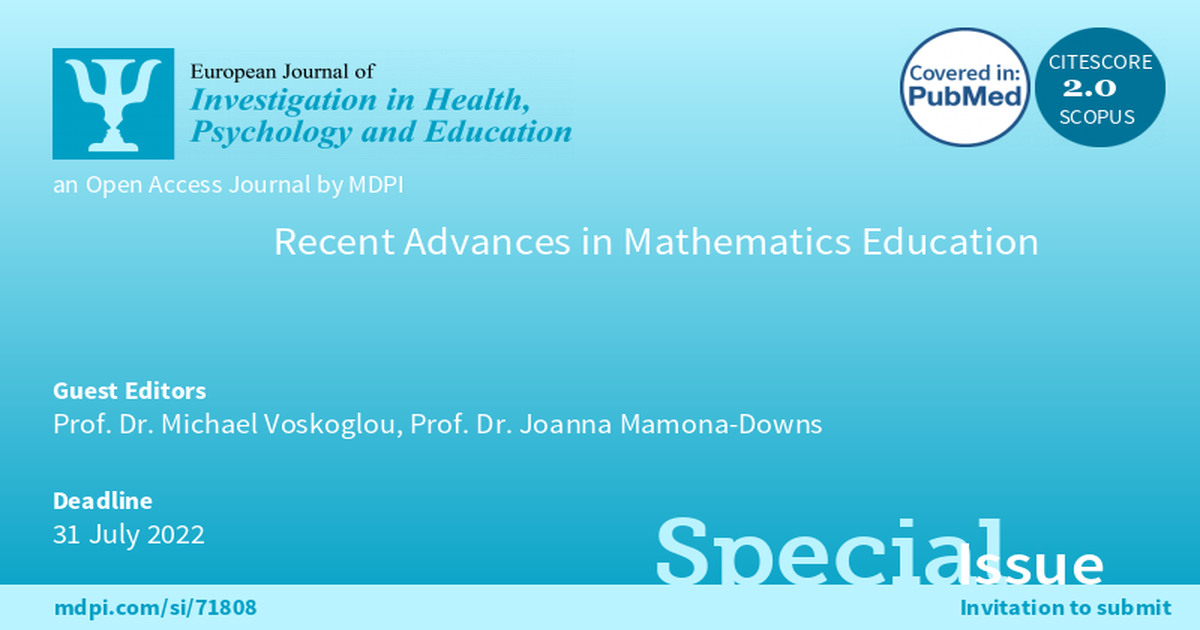- 2.6Impact Factor
- 5.1CiteScore
- 30 daysTime to First Decision
Recent Advances in Mathematics Education
Special Issue Information
Dear Colleagues,
The Special Issue ‘Recent Advances in Mathematics Education’ will focus on contemporary research outcomes and quality review papers regarding the teaching and learning of mathematics at all levels of education.
The proposed topics of this issue include, but are not limited to, the following:
(I) Themes of general interest
- Theories and methods of teaching and learning mathematics
- Problem solving and problem posing
- Mathematical modelling
- Argumentation and proof (pertaining to mathematical subjects)
- Computers and artificial intelligence in mathematics education
(II) Elementary Education
- Teaching and learning of arithmetic, geometry and statistics
- Special education
(III) Secondary Education
- Teaching and learning of algebra, geometry, calculus, probability and statistics
For Algebra: Themes as the transition from arithmetic to algebra, the difficulties brought by symbolization and the ways that students justify mathematical statements and propositions in the (new for them) symbolic environment.
For Geometry: Themes as the paradigm of Euclidean geometry and the effect of its gradual elimination on students’ ability to justify, prove and visualize.
For Calculus: Methods of teaching that enable a deep understanding of the basic concepts and principles of calculus.
For Probability and Statistics: Methods of teaching and usefulness in everyday life.
- Other mathematical topics in secondary education (logic, number theory, etc.)
- Education of mathematically gifted students: proposals with respect to the design of mathematical tasks that aim to assess and foster the mathematical giftedness and creativity of these students.
(IV) Tertiary Education
- Bridging the gap between mathematics taught at school and the subject as evolved at university level, especially the transition from calculus to analysis.
- Difficulties (and proposals on how to tackle them) concerning the fundamentals of number theory, combinatorics, abstract algebra and graph theory.
- Teaching new approaches of mathematics (fuzzy sets and systems, chaos theory and fractals, etc.)
Prof. Dr. Michael Voskoglou
Prof. Dr. Joanna Mamona-Downs
Guest Editors
Manuscript Submission Information
Manuscripts should be submitted online at www.mdpi.com by registering and logging in to this website. Once you are registered, click here to go to the submission form. Manuscripts can be submitted until the deadline. All submissions that pass pre-check are peer-reviewed. Accepted papers will be published continuously in the journal (as soon as accepted) and will be listed together on the special issue website. Research articles, review articles as well as short communications are invited. For planned papers, a title and short abstract (about 250 words) can be sent to the Editorial Office for assessment.
Submitted manuscripts should not have been published previously, nor be under consideration for publication elsewhere (except conference proceedings papers). All manuscripts are thoroughly refereed through a single-blind peer-review process. A guide for authors and other relevant information for submission of manuscripts is available on the Instructions for Authors page. European Journal of Investigation in Health, Psychology and Education is an international peer-reviewed open access monthly journal published by MDPI.
Please visit the Instructions for Authors page before submitting a manuscript. The Article Processing Charge (APC) for publication in this open access journal is 1600 CHF (Swiss Francs). Submitted papers should be well formatted and use good English. Authors may use MDPI's English editing service prior to publication or during author revisions.
Keywords
- mathematical learning
- smart learning systems
- problem solving
- problem posing
- mathematical modelling
- analogical and case-based reasoning
- critical thinking
- computational thinking
- mathematical proof

Benefits of Publishing in a Special Issue
- Ease of navigation: Grouping papers by topic helps scholars navigate broad scope journals more efficiently.
- Greater discoverability: Special Issues support the reach and impact of scientific research. Articles in Special Issues are more discoverable and cited more frequently.
- Expansion of research network: Special Issues facilitate connections among authors, fostering scientific collaborations.
- External promotion: Articles in Special Issues are often promoted through the journal's social media, increasing their visibility.
- e-Book format: Special Issues with more than 10 articles can be published as dedicated e-books, ensuring wide and rapid dissemination.

